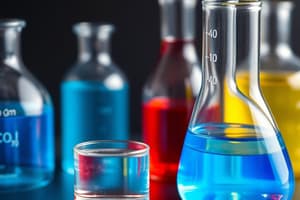Podcast
Questions and Answers
What defines a solution in chemistry?
What defines a solution in chemistry?
- A heterogeneous mixture of two or more substances
- A mixture with particles large enough to be filtered
- A mixture where the solute is settled at the bottom
- A homogeneous mixture of two or more substances (correct)
Which type of solution has dispersed particles larger than those in true solutions?
Which type of solution has dispersed particles larger than those in true solutions?
- Homogeneous (True) Solutions
- Gases
- Colloids (correct)
- Suspensions
In which type of solution are the solute and solvent in a single phase?
In which type of solution are the solute and solvent in a single phase?
- Homogeneous (True) Solutions (correct)
- Colloids
- Gases
- Suspensions
Which solution type has particles large enough to settle out or be filtered from the solution?
Which solution type has particles large enough to settle out or be filtered from the solution?
What distinguishes gases as a type of solution?
What distinguishes gases as a type of solution?
Which type of solution has the solute present in a smaller amount compared to the solvent?
Which type of solution has the solute present in a smaller amount compared to the solvent?
Which property of solutions depends on the number of particles and not their nature?
Which property of solutions depends on the number of particles and not their nature?
What does a high solubility of a solute in a solvent indicate?
What does a high solubility of a solute in a solvent indicate?
What happens to solubility as temperature increases for most substances?
What happens to solubility as temperature increases for most substances?
In a solution at equilibrium, what is true about the concentrations of solute and solvent?
In a solution at equilibrium, what is true about the concentrations of solute and solvent?
Which industry utilizes solution chemistry in drug formulation and dissolution studies?
Which industry utilizes solution chemistry in drug formulation and dissolution studies?
What do colligative properties of a solution depend on?
What do colligative properties of a solution depend on?
Flashcards are hidden until you start studying
Study Notes
Exploring Solution Chemistry
Solution chemistry is a fascinating branch of chemistry that delves into the behavior and interactions of substances in liquid mixtures, known as solutions. Whether you're interested in the color-changing magic of reaction mixtures or the industrial-scale production of pharmaceuticals, solution chemistry is central to many aspects of our world. Let's dive in to uncover the intriguing world of solutions.
What is a Solution?
A solution is a homogeneous mixture of two or more substances where the solute (the substance present in the smaller amount) is dissolved in the solvent (the substance present in the larger amount). The solute and solvent can be individual particles, molecules, ions, or atoms that form a homogeneous (uniform) mixture, meaning that the solute is evenly distributed throughout the solution.
Types of Solutions
Solutions can be classified according to the nature of the solute and solvent:
- Homogeneous (True) Solutions: The mixture is uniform throughout, and the solute and solvent are in a single phase.
- Colloids: Dispersed particles are larger than those in true solutions, resulting in a heterogeneous (non-uniform) mixture that appears uniform to the naked eye.
- Suspensions: Particles are large enough to settle out or be filtered from the solution, resulting in a heterogeneous mixture.
- Gases: A mixture of two or more gases in a confined space is a solution.
Solution Properties
Solutions have several properties that are often studied and measured:
- Concentration: The amount of solute per unit volume or mass of solvent.
- Osmotic Pressure: The pressure that must be applied to a solvent separated from a solution by a semipermeable membrane to prevent the net flow of solvent through the membrane.
- Solubility: The maximum amount of solute that can be dissolved in a given amount of solvent at a specified temperature and pressure.
- Colligative Properties: Properties of solutions that depend on the number of particles, not their nature. Examples include vapor pressure lowering, boiling point elevation, freezing point depression, and osmotic pressure.
Solution Formation and Solubility
Solutions form when the attractive forces between solute and solvent particles are greater than the attractive forces between solvent particles alone. A high solubility indicates that a solute dissolves easily in a solvent, while low solubility means that it dissolves slowly or not at all.
Factors that influence solubility include temperature, pressure, and the nature of the solute and solvent. As temperature increases, solubility generally increases for most substances, although there are some exceptions.
Solution Equilibria
Solutions can reach an equilibrium state, where the rate of solute dissolution equals the rate of solute precipitation. At this point, the concentrations of solute and solvent do not change, and the composition of the solution remains constant.
Applications of Solution Chemistry
Solution chemistry has a wide range of applications across diverse industries, including:
- Pharmaceuticals: Drug formulation, dissolution, and solubility studies.
- Agriculture: Fertilizers, crop protection agents, and biocides.
- Water treatment: Removal of pollutants, water purification, and wastewater treatment.
- Paint and coatings: Formulation of paints and coatings, solvent selection, and drying mechanisms.
- Food and beverages: Food preservation, food additives, and beverage formulation.
- Personal care products: Soaps, detergents, cosmetics, and toothpaste.
As you can see, solution chemistry is a fundamental and fascinating branch of chemistry that touches our daily lives. Whether you're performing a simple lab experiment or developing a new pharmaceutical, understanding solution chemistry is key to unlocking the potential of substances and their interactions.
Studying That Suits You
Use AI to generate personalized quizzes and flashcards to suit your learning preferences.




